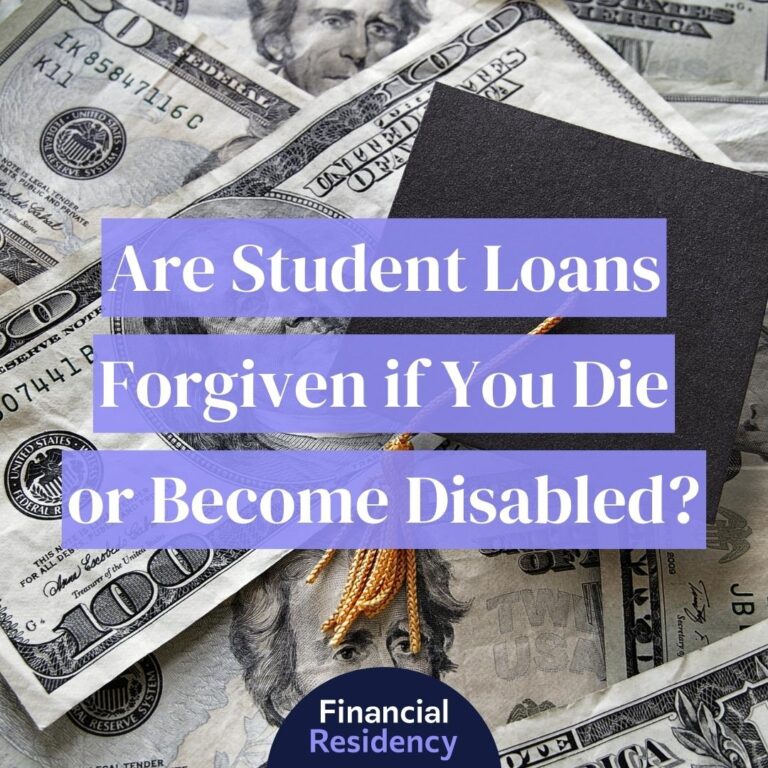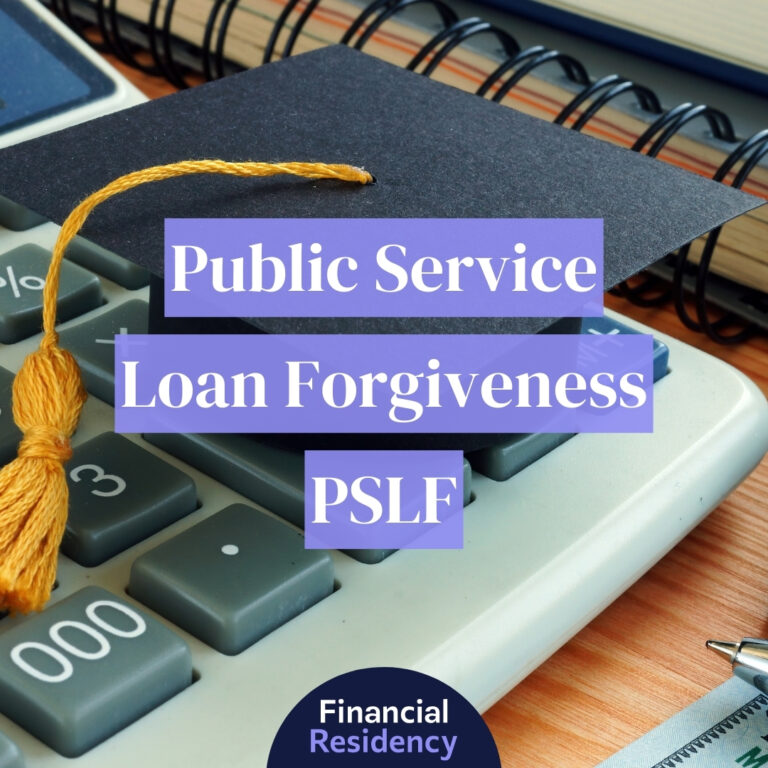For many medical school graduates, residency proves to be a challenging time financially. Looking for relief, often medical residents opt to go into student loan forbearance during residency. It’s quite common.
Not all loans offer a grace period to put their student loan payments on pause through forbearance.
But is this a smart decision to make or one that will make their student loans even more difficult to afford?
What exactly is forbearance, how does it affect your student loans, what other options do residents have if they can’t afford loan payments, and how does forbearance during residency hurt your future?
Let’s take a look.
What is Student Loan Forbearance?
Forbearance is a period of time when borrowers can postpone student loan payments. Many people choose forbearance because they are having trouble paying their monthly student loan payments.
Forbearance is available for federal loans as well as private, although federal loans generally offer better forbearance terms than private lenders.
There are two types of student loan forbearance available to choose from, general and mandatory. Mandatory is more common among doctors during residency.
Forbearance During Residency: General Forbearance
With this type of forbearance, your student loan lender can choose whether to approve you or not, which is why it is also referred to as discretionary forbearance.
General forbearance can be applied for if you are having trouble making student loan payments for these reasons:
- Financial hardship
- Medical expenses
- Employment Change
- Other Reasons approved by your lender
General forbearance is available for Direct Loans, FFEL Program loans, and Perkins Loans.
Forbearance is granted for no more than 12 months at a time. You can request another general forbearance when your time expires if you are still facing hardship.
Direct Loans and FFEL Loans: there is no limit on how long you can be in forbearance, but your lender may set a limit for you.
Perkins Loans: the maximum length is 3 years total.
For loans made under all three programs, general forbearances may be granted for no more than 12 months at a time.
Forbearance During Residency: Mandatory Forbearance
Mandatory forbearance is popular among resident doctors because lenders can’t deny you if you apply. This type of forbearance occurs because of extenuating circumstances that make it impossible to pay back your loan debt during that time.
Circumstances include, but are limited to:
- Medical or Dental Internship/Residency
- National Guard Duty
- Monthly payments are more than 20 percent of your monthly gross income
Forbearance for medical residency is only available for Direct Loans and FFEL Program loans.
Mandatory forbearance is granted for no more than 12 months at a time. You can request another mandatory forbearance when your current period expires. You could stay in forbearance for the length of your residency if you wanted through mandatory forbearance.
Why Do So Many Doctors Choose Forbearance During Residency?
Doctors choose forbearance during residency because it’s a popular option for doctors.
The average salary for residents in 2024 is $60,589. Compare that to the median student loan debt of $200,000 for 2021 medical school graduates. Resident doctors often feel like they just don’t make enough money for the 3 to 7 years of their residency to afford student loan payments on top of other living expenses.
Residency is a pivotal time if the life of doctors as well, with many important decisions occurring during this time. Forbearance is seen as the answer to not having to deal with student loan debt while living in this transition period.
Some student loans come with a grace period after graduation, where no loan payments are required. Direct Subsidized and Unsubsidized Loans have 6-month grace periods and Perkins Loans have 9-month grace periods. After that initial grace period, though, you are expected to start paying off your student loan debt. Some residents just don’t see that as a possibility.
Reasons to Avoid Forbearance During Residency
While forbearance seems like a good idea for doctors during residency, there are several reasons why it’s not the best option. In fact, choosing forbearance can increase your student loan debt drastically, making it harder to pay off in the long run. Here are some reasons to avoid forbearance.
Forbearance Doesn’t Pay Down Your Debt
When you choose forbearance, you are postponing payments on your student loans.
Say your residency lasts 3 years and you are able to get approved for forbearance for the entire period. If you had been making payments that entire time, you would be 36 payments in already, leaving you less debt to worry about when you are making a larger salary as a licensed physician.
Yes, you will have a higher salary to pay off your debt after residency, but all the extra interest negates that fact. Down the road, when you could be using that money towards something else, you will wish you just made the payments.
Forbearance Doesn’t Build Up Payments Towards Public Service Loan Forgiveness (PSLF)
If you are thinking about seeking student loan forgiveness, you are missing an opportunity by choosing forbearance.
First, in forbearance, you wouldn’t be making any qualifying payments towards PSLF. In order to be eligible for PSLF, you need to make 120 qualifying payments.
Think about how many qualifying payments you would be giving up if your residency lasted 3 years? How about 7 years? You would only need 36 more qualifying payments until you could apply for forgiveness.
To be approved for PSLF, you must be on a qualifying repayment plan, which includes:
- Pay As You Earn (PAYE)
- Revised Pay As You Earn (REPAYE)
- Income-Based Repayment (IBR)
- Income-contingent repayment (ICR)
- Standard 10-year repayment plan
Technically you can qualify for PSLF if you are on a standard 10-year repayment plan, but if you stay on that plan for the full 10 years, there will be very little or no debt left to be forgiven at the end.
If, however, you were to switch to one of the Income-Driven Repayment (IDR) plans, like PAYE or REPAYE, your payments will be significantly lower than standard payments, but would still count as qualifying PSLF payments.
Because payments would be based on your salary, residency is the perfect time to be on an IDR plan because of your lower salary. The specific plan that is best for you would depend on your goals, salary, family, and other factors.
Interest Doesn’t Stop Accumulating During Forbearance
When you are in forbearance, your student loan payments stop. That doesn’t mean, however, that they don’t accumulate interest. In fact, interest continues to accrue on both subsidized and unsubsidized loans and capitalizes yearly. That means interest is added to your loan principal balance. If you are pursuing Public Service Loan Forgiveness this won’t matter as much to you, but for everyone else, this is a huge financial hit to take.
Once you are out of forbearance, your principal balance will have grown by thousands of dollars because of this capitalized interest. Because your interest was added to your principal during forbearance, you are essentially paying interest on your interest. This is commonly known as compound interest.
You Miss Out on Tax Deductions
Residency is the one time in a doctor’s life that you can deduct student loan interest from your taxes. It’s a great perk, but one that you give up if you choose forbearance. In order to take advantage of this tax deduction, you have to be making student loan payments, which you aren’t doing during forbearance.
You can qualify for this deduction If your modified adjusted gross income (MAGI) is less than $80,000 or $160,000 if filing a joint return with your spouse. Modified adjusted gross income is simply your household’s adjusted gross income plus any tax-exempt interest income you may have.
Lost Subsidized Loan Benefits
Another reason to avoid forbearance is that you will lose subsidized loan benefits. If you have subsidized federal loans, under certain circumstances, the government pays part of your student loan interest. If you are enrolled in one of the income-driven repayment plans, depending on your income, your monthly payment might not be high enough to pay off accrued interest. The government will take care of the unpaid interest charged above your scheduled monthly payment your first three years of residency. This is referred to as negative amortization.
If you have federal subsidized loans and decide to enter forbearance, you will lose access to this benefit. This one perk alone could provide a savings of hundreds or even thousands of dollars.
Paying Student Loans With a Lower Salary Isn’t As Bad As You Think
The thought of graduating medical school and immediately getting hit with huge student loan payments can be scary. With so much transition in your life during this time, it’s easy to feel overwhelmed and think you can’t make your payments. However, if you enroll in the right income-driven repayment plan, your monthly student loan payments will end up being much lower, possibly even zero if you enroll before you start your residency.
Many medical students graduate and want to splurge to celebrate moving on from school to adulthood. Maybe a new car, a new wardrobe or even a new house or apartment. While those purchases are great and help you feel more like an adult, it makes more sense financially to get out from under your student loan debt during this time. It’s not fun to do necessarily, but neither is being in debt long term.
You may have to cut corners or give up some splurges in order to survive on a resident’s salary, but if the alternative is going into forbearance, work to cut your expenses and avoid the long-term cost forbearance can add. Ten years down the road you will look back and realize that paying your loans during residency wasn’t as difficult as it first seemed. You will be glad you had the foresight to make this wise financial decision and avoid forbearance.
Better Options than Forbearance for Doctors in Residency
If you haven’t realized it yet, forbearance should only be used as a last resort. It’s meant to be used in circumstances of real hardship so unless that’s your situation, choose another path for your student loans. What options are available that would be better than forbearance during residency?
Income-Driven Repayment Plans
If you have federal student loans and want to avoid forbearance, check out the income-driven repayment plans available through the government. There are 4 plans available:
The four income-driven repayment programs are:
- Pay As You Earn (PAYE)
- Revised Pay As You Earn (REPAYE)
- Income-Based Repayment (IBR)
- Income-Contingent Repayment (ICR)
Each plan is unique and has different perks and drawbacks. Take time to become familiar with all of the plans so you can choose the one that is right for you. That will mostly depend on your life goals, family, future income, and more.
Consolidate Your Student Loans
Consolidating your student loans into one direct federal loan can be done in conjunction with an income-driven repayment plan. This only is an option for your federal loans, not private loans. This is especially helpful if you are pursuing PSLF. If you have Federal Family Education Loans (FFEL) or Perkins Loans, they aren’t eligible for PSLF. That is unless you consolidate them to a federal direct loan. If you wait to do this until after your residency, you miss out on all of those student loan payments made during residency counting towards PSLF.
If you aren’t pursuing PSLF, consolidating loans is still helpful since you only have to keep track of one loan payment. Most residents have a combination of multiple student loans. There are other forgiveness options available through the PAYE and REPAYE repayment plans that could be options if you plan to work in the public sector.
Using Signing Bonus to Pay off Student Loan Debt
If you are coming near the end of your residency and are looking at long-term employment options, one thing you can do is try and negotiate a physician signing bonus. Signing bonuses are becoming more common these days. Refinance your student loans during residency and then use your signing bonus to make a lump sum payment. Lump sum payments are a great way to jumpstart your loan repayment. Also, cutting a large chunk of your loan principal will also save you thousands in interest over the life of your loans. Be sure to read your contract carefully and confirm it’s a signing bonus and not a loan or an advance that you will end up paying back.
See if you Qualify for Deferment Before Looking at Forbearance
If you feel you aren’t able to make your student loan payments during residency, deferment is another option to look at before forbearance. Deferment is very similar to a forbearance. You won’t have to make student loan payments during deferment. The difference is that you don’t have to pay interest during the deferment period for subsidized Stafford loans. If you have unsubsidized loans, interest will accrue and be capitalized just like it is with forbearance.
Deferment is not easy to qualify for and is limited in length usually, but it’s worth looking at if you aren’t able to make student loan payments because of various challenges, such as unemployment, financial hardship, or other reasons.
Living Frugally During Residency
Instead of choosing forbearance, you could simply spend the next few years continuing to live frugally. Avoid making big purchases. Cut back on eating out. Make financial decisions that offer flexibility in money gets tight. Medical residents generally work a ton of hours every week. Hold off on splurging on things like an upgrade in living arrangements or vehicle until you finish residency and can enjoy those purchases more. Take advantage of public transportation. Simplify your lifestyle and use that extra money to make your student loan payments. Living frugally isn’t always fun, but it beats adding thousands of unneeded dollars to your student loan principal.
While forbearance looks attractive and provides temporary relief during residency, for most people, there are far better choices to be made. Look at your financial situation carefully as well as your career, family, and life path to figure out the best option for you. Does it make sense to add more student loan debt later in life just to be able to skip payments now? Is it worth the extra interest you will pay if not pursuing PSLF? Ultimately that is your choice to make.



